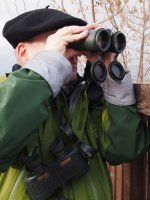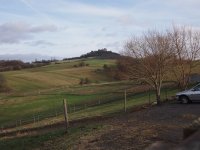oetzi
Well-known member
...after having used an Alpha for a (too short) time.
I went with a friend who had to tend her horses and used the opportunity to handle her Swarovision 10x42 (she is a birder and nature photographer since a very long time).
The "Veste Otzberg" was the object of observation with the Steiner Xtreme 8x30 and the Swaro 10x42. Here is what I found out.
In terms of sheer brightness, there is not that much of difference between the two.
The Swaro show a lot more of what I would call "micro contrast". And this made it so much better to see through. The grass showed so much more detail, for example.
The rooftops of the castle were perfect for checking CA.
The Steiner had a heap of it in center and much more on the edge. Remarkebly the Swaro wasnt CA-free in the center. Much less than the Steiner of course, but still visible and I would have expected not that much of it for the given price.
The FOV and the sharpness right to the edge was remarkably with the Swaro.
It was all there to see. (FOV can only be replaced by much more FOV, like with cylinder capacity on a motorbike)
(But I couldnt anyway. With both binos, every time I pan my eyes across the FOV towards the edge, there comes the moment when
-the outer part of the FOV first darkens and
-then turns black completely, shortening the FOV.)
What good is a wide FOV if I cant use it, other than with peripheral vision? Maybe someone can shed a light on what happened, I dont understand that sensation.)
So what is the consequence?
I am so glad to have bought a Nikon 8x30 EII and cant wait for it to appear at my doorstep.
What will I do if I were ever to buy a "bulletproof" roof? No way I will ever be able to spend "only" € 600,- like the Steiner costs (which is on loan anyway) and be happy with it.|=(|
I went with a friend who had to tend her horses and used the opportunity to handle her Swarovision 10x42 (she is a birder and nature photographer since a very long time).
The "Veste Otzberg" was the object of observation with the Steiner Xtreme 8x30 and the Swaro 10x42. Here is what I found out.
In terms of sheer brightness, there is not that much of difference between the two.
The Swaro show a lot more of what I would call "micro contrast". And this made it so much better to see through. The grass showed so much more detail, for example.
The rooftops of the castle were perfect for checking CA.
The Steiner had a heap of it in center and much more on the edge. Remarkebly the Swaro wasnt CA-free in the center. Much less than the Steiner of course, but still visible and I would have expected not that much of it for the given price.
The FOV and the sharpness right to the edge was remarkably with the Swaro.
It was all there to see. (FOV can only be replaced by much more FOV, like with cylinder capacity on a motorbike)
(But I couldnt anyway. With both binos, every time I pan my eyes across the FOV towards the edge, there comes the moment when
-the outer part of the FOV first darkens and
-then turns black completely, shortening the FOV.)
What good is a wide FOV if I cant use it, other than with peripheral vision? Maybe someone can shed a light on what happened, I dont understand that sensation.)
So what is the consequence?
I am so glad to have bought a Nikon 8x30 EII and cant wait for it to appear at my doorstep.
What will I do if I were ever to buy a "bulletproof" roof? No way I will ever be able to spend "only" € 600,- like the Steiner costs (which is on loan anyway) and be happy with it.|=(|
Attachments
Last edited:








